At Snowflake Air, we’re big fans of ductless mini splits. These heating and cooling systems do a fantastic job, and they cost less to run than conventional HVAC setups.
While they’re becoming more and more popular in Idaho, a lot of people here still don’t know much about them. Or, their opinion of them is outdated.
The original models, which came out decades ago, aren’t nearly as effective as the ones on the market today.
Regardless of the technology, however, many people simply can’t imagine what a mini split would look like if they installed it in their home. So, our topic for this article is the appearance and the sizes of the components that make up a ductless heating and cooling system.
Read More: How Do Mini Splits Work?
In this article, we’ll explain each component. Then, we’ll see how big each piece is and what options you have about where to install them. With most mini splits lasting up to 20 years, you’ll want to ensure you’re investing in the right equipment.
If you have any questions or want to find out more about installing a system in your home in or around Meridian, ID, call or email us at Snowflake Air. It’s important not only to have a professional design your customized system. You also need a contractor that’s certified to work on your brand to install your mini split.
Parts of a Ductless Mini Split
First, let’s get on the same page as far as terms and functions. A mini split consists of three parts: The heat pump, air handler, and line set.
Outside is a heat pump that gets rid of heat in your house in the summer. In the winter, it pulls heat from outside and compresses it so it’s strong enough to warm your home.
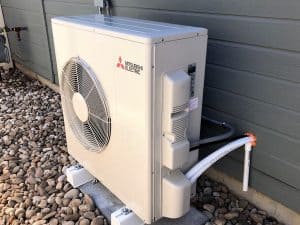
Inside, the air handler draws air from the room and circulates the treated air through the room as well.
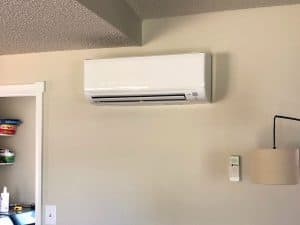
The line set connects the two. It pumps refrigerant back and forth to transfer heat. It also drains condensed water that collects during dehumidification in the summer.
We’ll get into the first two in more detail later. But, for now: the line set is narrow and flexible, so most times you don’t see it at all. We run the lines behind the wall like electrical wiring.
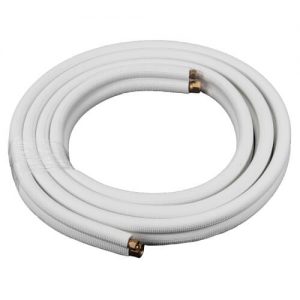
Now that we know what we’re working with, let’s answer a particular question we get a lot.
Does A Mini Split Heat and Cool?
Today’s ductless mini splits can heat and cool your home in any season. They work when it’s as cold as negative 13 degrees and will air condition in triple-digit temperatures.
Ductless mini splits used to be primarily for cooling. The heat pumps they used did a great job with air conditioning, but couldn’t keep a house warm. But, the technology behind them has grown in leaps and bounds over the last 20 years.
Today, a ductless heating and cooling system can replace any forced-air furnace and central air setup — to say nothing of radiators, baseboard heat, window air conditioners, or anything else.
We talked more about the benefits of these systems here. Right now, we just wanted to point out that, yes, today’s ductless systems can handle all heating and cooling.
Read More: How Much Does A Mini Split Cost for Homes in Boise, ID and Valley County?
How Big Is A Ductless Mini Split?
Most homes only need one mini split to heat and cool the entire house. That’s a heat pump with up to 8 air handlers attached to it. Now, let’s see how big each of these components are.
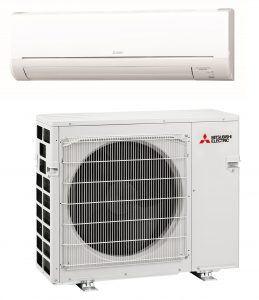
How Big Is a Ductless Heat Pump?
The average Mitsubishi ductless heat pump is 32 inches wide, 22 inches tall, and a foot in depth. It’s give or take only a few inches from model to model.
For comparison, the average conventional AC compressor is around 30 cubic inches or 30x30x30.
Since the heat pump is narrow, we can get it closer to your house and in smaller spaces than a condenser. That flexibility makes it easier to conceal. They’re also much quieter, so you can put it close or even on a deck or patio if you don’t have room elsewhere.
In fact, you can even put one underneath a deck — something you can’t do with a traditional unit.
The reason is the discharge: heat pumps have the exhaust on the side, while central air units have a fan pointing up. With the heat pump, you only need clearance on one side of the unit, not overhead.
How Big Is a Ductless Air Handler?
The average Mitsubishi high-wall air handler is about a foot tall, nine inches deep, and nearly three feet wide. Slightly less common are low-wall units that sit near the floor. Those are around 23 inches tall, 30 inches wide, and almost nine inches deep.
The other option is a recessed ceiling cassette. They go above your head and are flush with the ceiling, so they don’t take up room like the others.
Once again, the way this works gives you an advantage when it comes to where we install them.
Since these circulate the air exceptionally well, we can mount them in out-of-the-way spots. You can put a high-wall unit in a corner near the ceiling. Or, between two windows, in line with the tops of them, so there’s a consistent horizontal line that helps them blend in.
And, unlike ducts and vents, you won’t worry about blocking them off with furniture since we mount them well above your head.
Read Real Case Studies Of Mini Split Installations In Boise Metro and Valley County
What Size Mini Split Do I Need?
In this case, the “size” really means how many indoor units you’ll require. You can get one air handler to treat a single room, or install multiple ones to cover your entire home. Most heat pumps can support up to nine air handlers, which is often more than you need for a whole house.
Mini splits create “zoned” HVAC. Instead of one thermostat controlling the entire house, you use the thermostats on each air handler to control that room, area, or “zone” of your home.
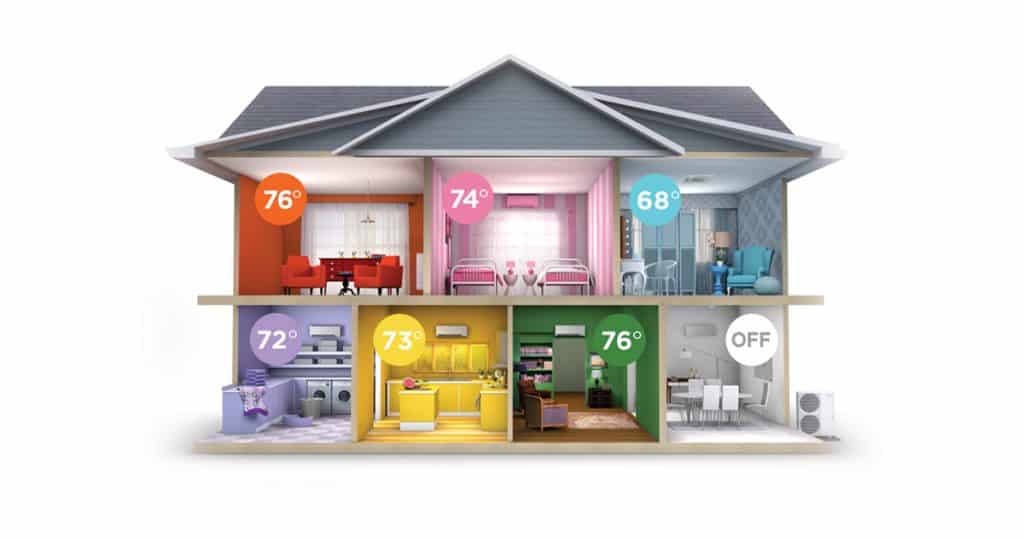
If you’re going for whole-home treatment, we’d assess the air circulation and layout of your home to determine exactly what you’d need. But, on average, four or five indoor units does the trick.
Read More: Rebates and Financing Options For Treasure Valley Heat Pump and Mini Split Installations
Ductless Mini Split Installations Near Meridian, ID
Snowflake Air is a Mitsubishi Diamond Contractor with an excellent reputation for installing mini splits in Meridian, ID, and other nearby towns. If you want to learn more about how a ductless mini split would work in your home, or if you’re ready to pick out a system, call or email us today!
Starting with a free consultation, we’ll assess your home and help you customize the setup that fits you perfectly.



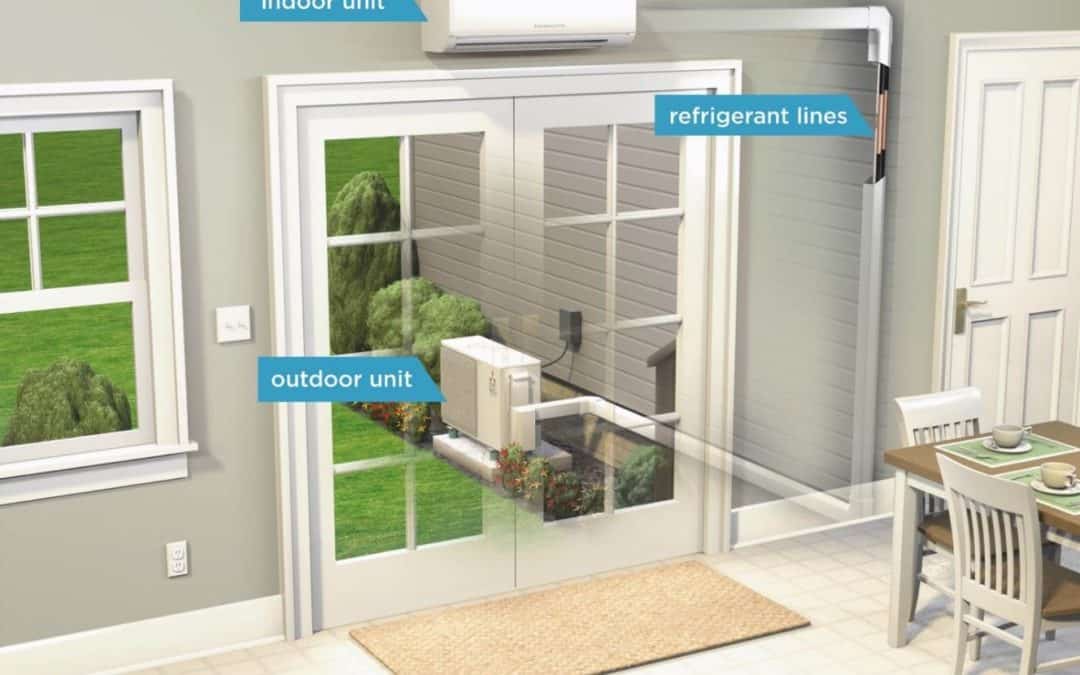

Trackbacks/Pingbacks